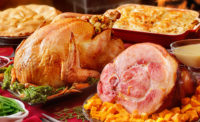Chicken - With a Twist
By Richard Mitchell
Editor, Meat & Deli Retailer
Editor, Meat & Deli Retailer
Processors who offer value-added chicken give retailers more potential to move their products quickly in response to consumer demand.
The fresh chicken market is getting a much needed merchandising jolt. While chicken remains a popular protein — with per capita consumption steadily on the upswing — more suppliers also are releasing new products and developing marketing campaigns that are intended to entice consumers to more frequently sample and purchase a wider range of poultry.
Producers are responding to the demands of large segments of convenience and health-conscious shoppers — and well as traditional chicken buyers — for meals that are quick and safe to prepare, and which feature new and exciting tastes. More retailers, meanwhile, are selling value-added products, including pre-marinated, precooked and pre-stuffed poultry in a plethora of flavors, and leveraging packaging that is designed to enhance freshness and reduce the threat of contamination.
“Fresh chicken consumption in the U.S. is growing 2 to 4 percent annually and that trend could accelerate with product innovations,” says Dave Hogberg, vice president of marketing for case ready meats for Springdale, Ark.-based Tyson Foods Inc. “The value-added items that will generate the most interest are those that meet consumers’ needs. Many products that might have scored well during concept testing are not totally successful because they were not developed using key consumer insights.”
The overall chicken market is indeed active, with the Washington, D.C.-based National Chicken Council projecting that per capita consumption in 2006 will total 89.5 pounds, up from 87.8 pounds in 2005 and 77.9 pounds in 2000.
Consumers will spend approximately $50 billion on chicken this year, and suppliers will produce about 35 billion pounds, says William P. Roenigk, National Chicken Council senior vice president.
Boneless, skinless breasts remain the most popular chicken product, and sales of the item and other poultry are likely to further increase with the release of more natural, organic and value-added meats, he notes.
Poultry producers and retailers are responding to the greater focus by consumers on healthy foods by merchandising new lines of natural and organic products. Tyson, for instance, recently released 100-percent all-natural chicken breasts that contain no artificial ingredients and were developed without added hormones or steroids. At the start of the calendar year, Pittsburg, Texas-based Pilgrim’s Pride launched its own line of all-natural chicken as well.
Denver-based Maverick Ranch Natural Meats, meanwhile, recently announced that it is expanding its organic offerings, and its goal within five years is to have the largest selection of organic poultry — as well as organic meats and oven-ready items.
Charley Moore, Maverick vice president of sales and marketing and a company owner, says organic products already account for about 25 percent of the company’s chicken sales.
“Consumers over the last three years have become much more educated about the benefits of organic and natural items,” he says.
Another supplier, Tecumseh, Neb.-based MBA Poultry, reports that sales of its organic chicken have grown by more than 225 percent over the last two years.
“Organic is a consistent theme and we can barely keep up with the demand,” says Erik Monson, vice president of sales, marketing and distribution.
By carrying larger varieties of fresh chicken — including natural and organic and value-added selections — conventional retailers are better positioned to challenge the supercenters and warehouse clubs that offer lower-cost poultry, says Jon Hauptman, vice president at Willard Bishop, a Barrington, Ill.-based retail consulting firm.
“Supercenters have a 13-to-18 percent price advantage over traditional supermarkets, but conventional merchants can compete on perishables quality, selection and service,” he notes. “Highlighting a strong fresh-chicken program can help retailers differentiate their operations and attract new business.”
Indeed, offering greater poultry selections is becoming an increasingly popular marketing strategy for merchants. For instance, Pittsburgh, Pa.-based Giant Eagle Inc., which operates 216 stores in Pennsylvania, Ohio, West Virginia and Maryland, recently rolled out Giant Eagle-branded, 99-percent fat-free and hand-trimmed boneless chicken breasts.
The chain also introduced a full line of all-natural chicken, beef and pork under the company’s Nature’s Basket brand. Chicken products include Boneless Cutlets, Thin-sliced Boneless Breasts, Drums, Thighs, Boneless Thighs and Whole Fryers. Items are merchandised with case dividers, rail strips, overhead signs, floor decals, on-pack labels and vertical case callouts that designate the natural section.
Ed Steinmetz, Giant Eagle vice president of meat, seafood and prepared foods, says the rollouts were in response to escalating consumer interest in natural and convenience-oriented products.
“There is much room in poultry for research and development and innovation,” he says. “The category had been stagnant, but things are being done to sell more products.”
Indeed, Tyson is extending its poultry line with the launch of Trimmed & Ready fresh chicken products, which are hand-trimmed of skin and excess fat to enable convenience-oriented consumers to cook the items straight from the package.
Maverick Ranch Natural Meats carries 22 fresh valued-added chicken products in a category it calls “oven-ready entrees.” The top-selling items are a boneless, skinless breasts stuffed with cheddar cheese and asparagus spears, and fresh chicken parmesan.
“The average consumer doesn’t have time to gather the ingredients and cook from scratch,” Moore says. “Many also lack the skills and energy to prepare a meal and then clean up.”
Newer choices are a necessity if merchandisers are to sustain and expand interest in chicken, and meet the culinary demands of different demographic groups, including the fast-growing Hispanic and Asian populations, analysts says. Many households in both segments favor chicken dishes, they note.
“The constituency is changing and we need to market to them,” says Dan Emery, vice president of marketing for Pilgrim’s Pride Corp. “Retailers can’t have a cookie-cutter approach. They have to find out who their customers are and to make sure offerings meet the needs of those shoppers.”
John Grubb, managing director and a partner with Sterling-Rice Group, a Boulder, Colo.-based brand strategy consulting firm, agrees that the one-size-fits-all approach is not a productive method for marketing chicken.
Grubb notes that it is essential for retailers to offer items that are easy to prepare and contain cooking instructions and recipes. Research by the Sterling-Rice Group — which included organizing focus groups, visiting stores with shoppers and observing consumers’ at-home behavior — found that cooking intimidates many persons, and that a large segment of individuals are likely to purchase items that don’t require trimming, marinating or even handling.
“I’m stunned at what reluctant cooks young people are,” Grubb notes. “Many of them have never seen the inside of an oven and just use the microwave or top of the stove. Part of the reason is time constraints, and the other is not having the necessary skills. They grew up with convenient solutions, such as semi-prepared products.”
Many consumers also are reluctant to prepare fresh chicken because they say the damp uncooked meat is messy, and they are concerned about the health consequences from touching raw chicken, analysts note. Such issues are driving the development of packaging that eliminates the need for cooks to handle poultry during preparation, while also preventing leakage.
More suppliers, for instance, are marketing packages of boneless, skinless breasts with pieces that are individually wrapped in vacuum-packed film. The design enables consumers to immediately freeze the pieces after purchase without rewrapping the products at home. The method adds convenience while reducing the threat of contamination and freezer burn.
Gold Kist Inc., an Atlanta-based chicken producer, began testing its Fridge to Freezer packaging about a year ago. Costco Wholesale carries the packs — which feature the Gold Kist and Kirkland Signature brands — at its locations in the eastern half of the U.S.
Costco uses saddleback-style packaging that contains six individual pouches, with each pouch holding two breasts.
“The packaging enables consumers to take home large quantities of chicken, which they can use in smaller amounts in a portion-controlled form,” says Greg Moore, Gold Kist marketing director.
Doug Holbrook, Costco assistant general merchandise manager, fresh meat and corporate foods, says the packaging has virtually eliminated the leakage that resulted from the stacking of large packages of chicken in store cases.
“Consumers have moved away from the whole-body fryers and want more parts and pieces, such as boneless, skinless breasts,” he notes. “Members have accepted the saddleback packaging because it is user friendly. They can buy breasts in bulk with the items already sealed.”
While packaging that streamlines preparation and cleanup — and upgrades the appearance of products — is likely to entice more consumers to cook fresh chicken, retailers and suppliers looking to sustain sales also must consistently offer new case-ready selections and distribute easy-to-follow recipes, analysts note.
Indeed, Scott McNair, Tyson senior vice president of case ready meats, says the category is ripe for an overhaul, as today’s case-ready poultry almost mirrors the items that were available 30 years ago.
“Other categories are changing, but the case-ready sector has been neglected over the years,” he notes. “It has been treated like a commodity.”
Hogberg says that spicing up the case by adding new value-added items also can enable retailers to substantially increase revenues.
“Value-added may contribute just 1 percent to overall volume, but can have a more than 20-percent profit margin,” he adds. “It is important for retailers to see the margin opportunity rather than tonnage.”
It also is crucial for merchants to provide product sampling and distribute recipes, cooking instructions and nutritional data to spur poultry sales, analysts say.
Indeed, Grubb notes that the dissemination of product and preparation literature is vital because many shoppers — not wanting to reveal their culinary ignorance — are reluctant to ask butchers or other retail associates for information and cooking advice.
“Merchants to be successful have to figure out how to make their customers winners in the kitchen,” he says. “A lot of shoppers are too intimidated to buy new items, and it is easy to underestimate how hard it is for them to break out of their comfort zones. Yet chicken — more than other protein — is hard to mess up and easy to experiment with. And experimentation should be advocated by retailers.”
Pilgrim’s Pride is among the processors providing labels with serving suggestions on packages, and the company also distributes recipes and coupons via the Internet to consumers who sign up for the supplier’s recipe club.
“People’s palates are more adventurous and they want pizzazz in their foods,” Emery says.
Retailers also can generate greater activity across the entire fresh chicken category by creating separate sections for different products within the case — such as pre-marinated and fully cooked chicken — and installing signage that enables consumers to easily locate the items, says Tracy Miller, senior product development manager for Gold’n Plump Poultry, a Minneapolis-based producer.
“Consumers take 30 to 90 seconds to make a purchase decision at the shelf, so it is important to make a quick impression,” she adds.
Many analysts say the fresh chicken market will be characterized over the next several years by the rollout and popularity of additional convenience-oriented foods, such as new pre-marinated and fully cooked selections, and the further growth of natural and organic products. More retailers also are likely to emphasize total meal solutions by merchandising chicken along with salads and side dishes.
“Poultry is a healthy center-of-the-plate product, and anything merchants can do to make it easier to cook at home will be a big selling point,” Hauptman adds. NP
Richard Mitchell is the editor of Stagnito’s Meat & Deli Retailer magazine.




Report Abusive Comment